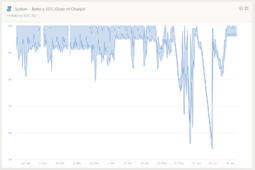My setup was engineered in ignorance of the physical capabilities of the panels, the amount of sunlight that would be received in rainy weather, etc. I had believed that the rainy season would test the battery capacity much more than it has, so I may have overbuilt to compensate. Now, in the actual rainy season, the LiFePO4 powerwall battery is only dropping to around 84% at night, which is replenished within 2-3 hours in the morning, even in cloudy weather. This cycles daily, but is not reaching the 80-20 capacity window at all. Is this a problem?
I searched the forum before posting, and found only one thread that appeared to address a similar scenario...however, the answer given was premised with "it has been said" and "probably...." I would appreciate something more definitive and/or based on actual testing or experience.
I searched the forum before posting, and found only one thread that appeared to address a similar scenario...however, the answer given was premised with "it has been said" and "probably...." I would appreciate something more definitive and/or based on actual testing or experience.



